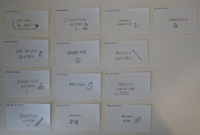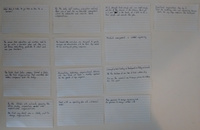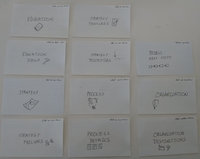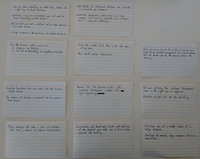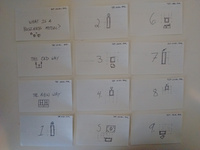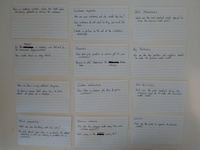What used to be done, what we now know, and the top level of the business model canvas.
Research of known effective materials:
Udacity course: How to Build a Startup
Lesson 1: Before you get started
Lesson 2: What we now know
Lesson 3: Business Models and Customer Development
Lean startup by Eric Ries
Incorporation:
Card deck one of three: What used to be done?
Why are you here?
What does it take to go from an idea to a business?
For the last 20 years, the answer from educators and investors used to
be: go write a business plan and then you will know everything possible
to start and run your business.
##### Education #####
Dutch east indies company in 1602 was the first organization that
resembled what modern companies look like today.
By 1850's with railroads spanning the entire country, corporations
needed more sophisticated organizations.
The first org chart was in 1856 just to manage organizations
By early 20th century educators realized there was a need for an
educated management class to administer and execute these
corporations.
The Harvard MBA curriculum was designed to provide managers and
administrators with the tools they needed to run existing and growing
companies. Accounting, leadership, organizational behavior etc. This
stack of tools is incredibly important for the growth of large
companies.
##### Strategy #####
Start with an operating plan and finanical model.
If i thought hard enough and was smart enough, and did all the research
in the library. then if i put the 5 year plan in the back all i need to
do is hire the people and execute the plan.
##### Process #####
Product management + waterfall engineering
Concept -> Seed funding -> Development -> Testing -> Launch
All the features at one time at first customer ship.
That was the canonical way to manage the process for startups for 40
years.
Many processes to manage engineering risk.
No processes to manage customer risk.
##### Organization #####
Functional organizations from day 1. Silos for marketing, sales and
engineering because that's the way large companies were structured.
Card deck two of three: What we now know
##### Education ##### We now know something we didn't know before, the right way to build startups. Eventually if you are succesful you will need to know everything an MBA knows. But at first you need a different set of skills that never existed before. Large companies do execution, new ventures do search. Use the business model canvas to 1. Organize our thinking 2. Get out of the building, turn hypothesis into facts ##### Strategy ##### Use the business model canvas to capture the hypothesis for our model. The canvas will become a scorecard for how much we have learned. More startups fail from a lack of customers than from a failure of product development. 80-90% of software features are unwanted or unneeded by customers. Waterfall development makes sense in a large company with existing products and customers but is wrong for startups. Find the model first, then write the operating plan. Real facts before forecasts. ##### Process ##### The process that searches for the business model is: Customer development coupled with an agile engineering process. Incrementally and interatively build each portion of the product and make sure it has a home outside the building. Once you have found the model, of course you want to do product management in a formal process like agile or waterfall development, but not before you do the planning before the planning. ##### Organization ##### For new ventures, Customer development team is the right way to organize. Founder -> Get out of the building Startups are not a smaller version of a large company Startups do search, large companies focus on execution
Card deck three of three: Top level of business model canvas
What is a business model? How a company creates value for itself while delivering products or services for customers. In the old days a company was defined by it's functional organization. You would draw an org chart. Now we draw a very different diagram. We draw a canvas that shows how to think about all the pieces of a business. 1. Value proposition: What are you building and for who? It's not about your idea or product, it's about solving a need or a problem for a customer. 2. Customer segments: Who are your customers, and why would they buy? Your customers do not exist to buy. You exist for them. Create a picture on the wall of the customer archetype. 3. Channels: How does your product or service get to your customer? Physical or web? Understand the relationship between them. 4. Customer relationships: How does a company get, keep & grow customers? 5. Revenue streams: How does the company make money from each customer segment? What value is the customer paying for? 6. Key Resources: What are the most important assets required to make the business model work? 7. Key Partners: Who are the key partners and suppliers needed to make the business model work? 8. Key Activities: What are the most important things the company must do to make the business model work? 9. Costs What are the costs to operate the business model?
Execution:
Lessons learned:
Metrics on memorization:
First and second half of "What used to be done" card stack took approximately 1.5 hours spread over a 7 hour interval with many interruptions.
During this process, it is possible to augment the memorization by writing the cards out. By presenting the front of the cards and then typing the contents in the text file. This approach can facilitate memorization where speaking out loud is distracting to others.
First half of "what we now know" card stack from education through strategy took 25 minutes for initial pass memorization. Second half in 13 minutes. Combined review: 2:45 first pass correct.
40 minutes for the 11 cards in the "what we now know" card stack.
Card deck three "Top level business model canvas" took 19 minutes for full in-order memorization.
Then put all three card stacks in random order for memorization. Made 4-5 passes with 1 or 2 of the same cards having a failure mode. That's about a 3% card failure rate.
Performed self-talk part on a 2+ hour drive on route 64 west, starting immediately after eating first meal of the day at 10:30.
The surprising thing here was the challenge of refinement of the lecture materials into a set of one-page groupings. I expected some difficulty, but the number of iterations and the time required to select and refine the core concepts was longer than anticipated. This was the goal however. It was supposed to take however long it took until you could create memorization entries as part one of incorporation section of the research, incorporation, and execution cycle.
Also a surprise was the time required to physically write out the cards.
In addition, it has become evident that the order of the cards provides a narrative capability that has value. Memorize them in order at first, then verify the full random order memorization. Random order memorization is essential for interrogative response. Knowing the cards backwards and forwards is essential to bridging the gap between intellectual and intuitive knowledge. However, for certain environments the full memorization of the cards in order provides a story-based approach that has unique value.
Also learned was the documentation of how the one page components were split out into cards. For ease of re-creation and consistency, the cards are photographed front and back in order of memorization. If you lose a card stack or they get out of order, consult the images here for recreation of how the content of the text above is split into card stacks.
